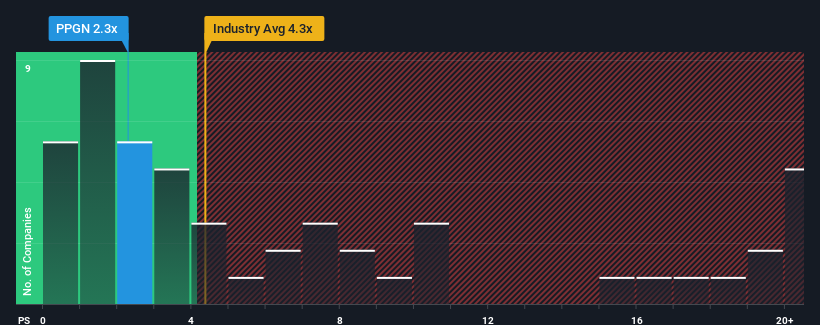- Switzerland
- /
- Life Sciences
- /
- SWX:PPGN
Further Upside For PolyPeptide Group AG (VTX:PPGN) Shares Could Introduce Price Risks After 33% Bounce
PolyPeptide Group AG (VTX:PPGN) shareholders would be excited to see that the share price has had a great month, posting a 33% gain and recovering from prior weakness. Looking further back, the 15% rise over the last twelve months isn't too bad notwithstanding the strength over the last 30 days.
Although its price has surged higher, PolyPeptide Group's price-to-sales (or "P/S") ratio of 2.3x might still make it look like a strong buy right now compared to the wider Life Sciences industry in Switzerland, where around half of the companies have P/S ratios above 5.2x and even P/S above 9x are quite common. Although, it's not wise to just take the P/S at face value as there may be an explanation why it's so limited.
Check out our latest analysis for PolyPeptide Group

What Does PolyPeptide Group's Recent Performance Look Like?
PolyPeptide Group certainly has been doing a good job lately as it's been growing revenue more than most other companies. Perhaps the market is expecting future revenue performance to dive, which has kept the P/S suppressed. If you like the company, you'd be hoping this isn't the case so that you could potentially pick up some stock while it's out of favour.
If you'd like to see what analysts are forecasting going forward, you should check out our free report on PolyPeptide Group.Do Revenue Forecasts Match The Low P/S Ratio?
PolyPeptide Group's P/S ratio would be typical for a company that's expected to deliver very poor growth or even falling revenue, and importantly, perform much worse than the industry.
Retrospectively, the last year delivered an exceptional 16% gain to the company's top line. The strong recent performance means it was also able to grow revenue by 45% in total over the last three years. Accordingly, shareholders would have definitely welcomed those medium-term rates of revenue growth.
Turning to the outlook, the next three years should generate growth of 14% each year as estimated by the four analysts watching the company. That's shaping up to be materially higher than the 9.3% each year growth forecast for the broader industry.
In light of this, it's peculiar that PolyPeptide Group's P/S sits below the majority of other companies. It looks like most investors are not convinced at all that the company can achieve future growth expectations.
What We Can Learn From PolyPeptide Group's P/S?
Even after such a strong price move, PolyPeptide Group's P/S still trails the rest of the industry. We'd say the price-to-sales ratio's power isn't primarily as a valuation instrument but rather to gauge current investor sentiment and future expectations.
To us, it seems PolyPeptide Group currently trades on a significantly depressed P/S given its forecasted revenue growth is higher than the rest of its industry. When we see strong growth forecasts like this, we can only assume potential risks are what might be placing significant pressure on the P/S ratio. At least price risks look to be very low, but investors seem to think future revenues could see a lot of volatility.
You should always think about risks. Case in point, we've spotted 1 warning sign for PolyPeptide Group you should be aware of.
If these risks are making you reconsider your opinion on PolyPeptide Group, explore our interactive list of high quality stocks to get an idea of what else is out there.
New: Manage All Your Stock Portfolios in One Place
We've created the ultimate portfolio companion for stock investors, and it's free.
• Connect an unlimited number of Portfolios and see your total in one currency
• Be alerted to new Warning Signs or Risks via email or mobile
• Track the Fair Value of your stocks
Have feedback on this article? Concerned about the content? Get in touch with us directly. Alternatively, email editorial-team (at) simplywallst.com.
This article by Simply Wall St is general in nature. We provide commentary based on historical data and analyst forecasts only using an unbiased methodology and our articles are not intended to be financial advice. It does not constitute a recommendation to buy or sell any stock, and does not take account of your objectives, or your financial situation. We aim to bring you long-term focused analysis driven by fundamental data. Note that our analysis may not factor in the latest price-sensitive company announcements or qualitative material. Simply Wall St has no position in any stocks mentioned.
About SWX:PPGN
PolyPeptide Group
Operates as a contract development and manufacturing company in Europe, the United States, and India.
Reasonable growth potential with adequate balance sheet.
Similar Companies
Market Insights
Community Narratives


Recently Updated Narratives


Engineered for Stability. Positioned for Growth.


MINISO's fair value is projected at 26.69 with an anticipated PE ratio shift of 20x


Fiverr International will transform the freelance industry with AI-powered growth
Popular Narratives


MicroVision will explode future revenue by 380.37% with a vision towards success


NVDA: Expanding AI Demand Will Drive Major Data Center Investments Through 2026



